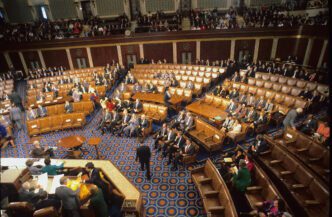Executive Summary
- The Trump administration’s General Services Administration (GSA) is rehiring hundreds of federal employees laid off under Elon Musk’s Department of Government Efficiency (DOGE) initiative, reversing previous cost-cutting policies due to understaffing and operational challenges.
- The extensive layoffs left the GSA “broken and understaffed,” struggling with basic functions, incurring unexpected costs for properties, and ultimately failing to deliver the promised savings from DOGE’s initiatives.
- This rehiring at the GSA is part of a broader trend across several federal agencies affected by DOGE’s cost-cutting, which Democrats criticize for creating costly confusion and undermining essential taxpayer services.
The Story So Far
- The Trump administration, through its Department of Government Efficiency (DOGE), initiated aggressive cost-cutting measures at the General Services Administration (GSA), resulting in significant layoffs and plans to divest federal properties. However, these reductions, intended to streamline operations and save money, severely understaffed the agency, leading to operational failures, increased costs, and a failure to achieve the promised savings, thereby necessitating the current reversal and rehiring of employees.
Why This Matters
- The Trump administration’s decision to rehire hundreds of GSA employees, reversing earlier layoffs under the Department of Government Efficiency (DOGE), signifies that aggressive cost-cutting measures created significant operational challenges and financial inefficiencies across federal agencies, rather than delivering promised savings. This widespread reversal, also seen at the IRS and Labor Department, underscores a broader acknowledgment that these drastic workforce reductions were detrimental. The situation highlights ongoing political and financial scrutiny of the Trump administration’s approach to government efficiency, with critics arguing the cuts led to costly confusion and undermined essential services.
Who Thinks What?
- GSA leadership, under the Trump administration, is rehiring employees to make adjustments in the best interest of customer agencies and American taxpayers, implicitly acknowledging that previous workforce reductions led to operational challenges.
- Former GSA real estate officials, like Chad Becker, believe that the Department of Government Efficiency’s (DOGE) cost-cutting initiatives went “too far, too fast,” leaving the agency “broken and understaffed” and struggling to perform basic functions.
- Democrats, represented by Greg Stanton, criticized the Trump administration’s approach, arguing that the reductions created “costly confusion,” undermined essential services, and failed to deliver any actual savings.
The Trump administration’s General Services Administration (GSA) is rehiring hundreds of federal employees who were laid off as part of Elon Musk’s Department of Government Efficiency (DOGE) cost-cutting initiatives. This move signals a significant reversal of previous policies, with the agency acknowledging that aggressive reductions left it understaffed and facing operational challenges. Employees, who primarily managed government workspaces, have been given until the end of the week to accept reinstatement, with a report date set for October 6.
Operational Fallout and Reversals
The layoffs, which saw thousands of GSA employees leave through voluntary programs and hundreds dismissed, resulted in the agency struggling to carry out basic functions. According to Chad Becker, a former GSA real estate official, the agency was left “broken and understaffed” and has been in “triage mode” for months. This sudden reversal, Becker stated, reflects that DOGE’s approach went “too far, too fast.”
In some instances, the GSA incurred high costs to maintain properties whose leases it had previously slated for termination. These operational difficulties underscore the challenges faced by the agency in the wake of the extensive workforce reductions.
Broader Trend of Rehiring
The GSA’s decision to rehire employees is not an isolated incident. Similar efforts are underway at several other federal agencies that were targeted by DOGE. Last month, the Internal Revenue Service (IRS) allowed some employees who had accepted resignation offers to remain on the job. The Labor Department has also brought back staff, and the National Park Service earlier reinstated a number of purged employees.
The GSA, established in the 1940s, plays a critical role in centralizing the acquisition and management of thousands of federal workplaces, making its staffing levels crucial for government operations.
Agency Response and Political Criticism
GSA representatives declined to respond to detailed questions regarding the return-to-work notice, headcount, staffing decisions, or potential cost overruns. An agency spokesman, however, stated, “GSA’s leadership team has reviewed workforce actions and is making adjustments in the best interest of the customer agencies we serve and the American taxpayers.”
Democrats have strongly criticized the Trump administration’s approach to slashing costs and jobs. Representative Greg Stanton of Arizona argued that there is no evidence the reductions at the agency delivered any savings. He added that the cuts have “created costly confusion while undermining the very services taxpayers depend on.”
DOGE’s Initial Goals and Actual Outcomes
At the start of the Trump administration, DOGE identified the GSA, which then had approximately 12,000 employees, as a primary target in its campaign to reduce fraud, waste, and abuse. A small group of Elon Musk’s trusted aides pursued ambitious plans to abruptly cancel nearly half of the 7,500 leases in the federal portfolio and sell hundreds of federally owned buildings.
However, these massive job cuts and property divestment plans produced little in the way of promised savings. Significant pushback to the GSA’s intended dumping of its portfolio led to both initiatives being dialed back, with more than 480 leases slated for termination now spared. DOGE’s “Wall of Receipts,” which once boasted nearly $460 million in savings from lease cancellations, reduced that estimate to $140 million by the end of July.
The administration’s decision to slash GSA’s headquarters staff, portfolio managers, and facilities managers had tangible negative consequences. For example, 131 leases expired without the government vacating the properties, exposing agencies to steep fees and further financial strain.
Ongoing Scrutiny
The Government Accountability Office (GAO) is currently examining the GSA’s management practices following these events. The GAO is expected to issue its findings in the coming months, which may shed further light on the financial and operational impact of DOGE’s initiatives and the subsequent reversals.








